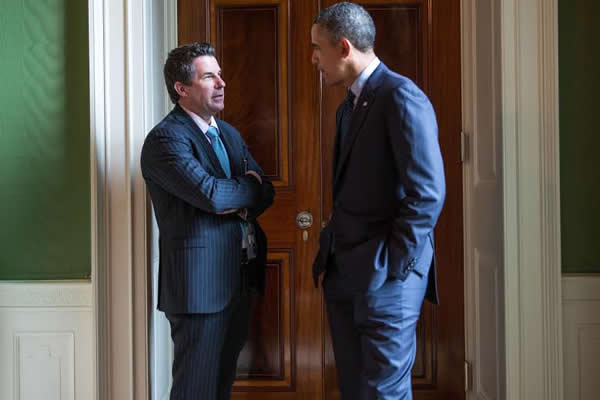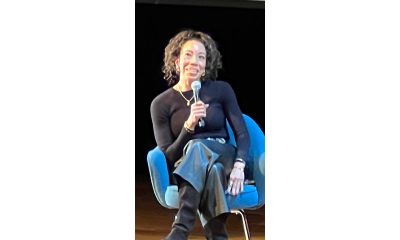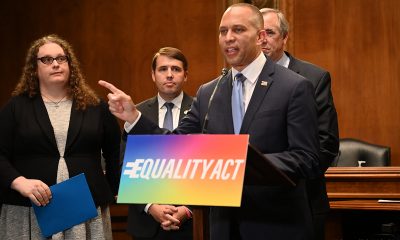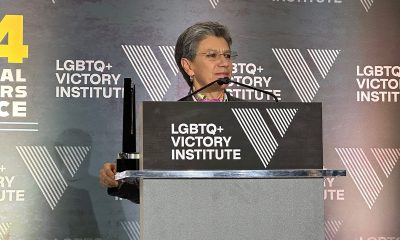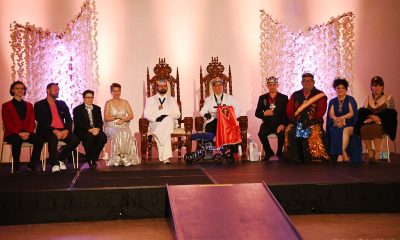a&e features
‘The first lady is a beautiful person inside and out’
Makeup artist Carl Ray assists Michelle Obama with her public face
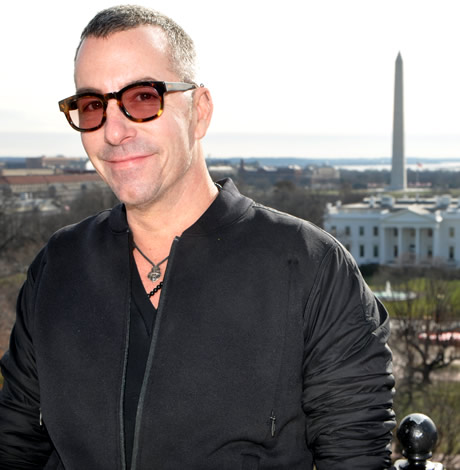
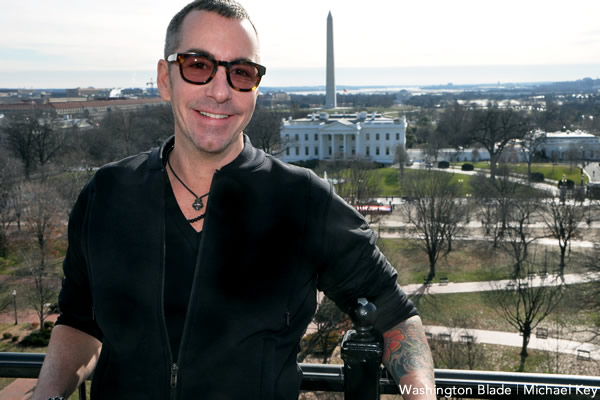
‘Working with her is a great experience, the honor of a lifetime,’ says Carl Ray, who works as first lady Michelle Obama’s makeup artist. (Washington Blade photo by Michael Key)
As a child, he first began applying makeup to the visage of the most important woman in his life. An aptitude for art and affinity for beauty would eventually lead to doing the same for the first lady of the United States.
At age 14, now long prominent and locally pioneering D.C.-based makeup artist Carl Ray casually commented to his mother while she was seated at her vanity mirror, “I don’t think you’re doing that right.” His keen painterly instinct and developing eye for facial enhancement so impressed her that she insisted on his assistance each morning, even waking him up at times to work his magic. Recently divorced from his father, Ray wanted to get her out on dates and happily re-married. He succeeded.
A quick study at honing a fascination for fashion and the styles of the day, Ray was drawn to immersing himself in red-carpet looks and celebrity runway appearances through the pages of magazines.
An only child, born at Andrews Air Force Base in Prince Georges County, Navy brat Ray would spend his early years growing up in Italy, Morocco and Puerto Rico. He returned to the U.S. with his parents to attend junior high school in Virginia Beach.
Accustomed to living near water, the athletic Ray excelled as a high school swimmer, winning state and AAU competitions. Up early every morning to hit the pool, he was known for his breaststroke prowess and also as an avid and accomplished surfer. The popular athlete often hung out with the girls in his classes and dated cheerleaders.
“I did the whole girlfriend thing,” the 49-year-old Ray says, noting he had “never met a gay person and didn’t know what that meant. I just thought I was a weirdo for being attracted to men. But I knew it was something people disapproved of being.”
Also a member of the baseball team, Ray played first base and was a pitcher. “I still am,” he says with a hearty laugh. He came out to his friends shortly before graduation.
He would next earn an associate degree in business while studying commercial art. Ray discovered that painting helped him overcome dyslexia through concentration on activities focusing the right side of his brain. Impressionism was his early love, later developing a more abstract style on the canvas. A painter’s brushes and an artist’s color blending captivated his attention, later fueling a self-taught career.
“I became a fiend for art, painting and photography,” Ray says.
Moving to D.C. in 1991, Ray said the city reminded him of his youth in Europe. His childhood experiences drew him to “a lively city with an abundance of culture,” even if D.C. was more conservative in tone and texture. He soon landed a job at a trendsetting high-end cosmetics and luxury beauty product retailer on Connecticut Avenue near Dupont Circle. He quickly developed relationships with visiting brand representatives, who recognized his interest in makeup and skin care when introducing new products to staff.
“It was a very organic path to a career,” Ray says. “I established a niche for myself as the first resident makeup artist.” He assisted customers in selecting products and training them on how to use and apply them. “I understood that I had a talent and an ability to make women look and feel beautiful.”
Customers began requesting appointments with Ray, hoping he would help them determine what skin care regimens, makeup products and colors, and application techniques would work best for them. He had created his dream job.
“D.C. was playing catch-up in the field and the time was right,” he says. “The opportunity to evolve our services allowed me to pioneer an in-house position that existed in only a few cities then and is more available in D.C. now.”
Ray, who is single, describes himself as a “bridal guru.” He refers to weddings as the closest thing to a “runway event” in local lifestyles. As he developed a client roster, Ray welcomed a bride’s makeup request for a high-profile Georgetown wedding, a service that has since grown to become a specialty.
It was that wedding engagement as an on-site makeup artist that propelled Ray to seek an advance in his then-nascent career in 1999. With only a magazine tear sheet of the nuptial event coverage highlighting his bridal makeup artistry, he walked into the premier salon in D.C. hoping to interest management in bringing him on as their first makeup specialist. He was hired, both for his craft and his chutzpah, and has been the exclusive Artistic Talent at the George Salon at the Four Seasons Hotel ever since.
Recalling his early days at the salon being like “a fish out of water,” Ray would float through the space “bravely” offering to apply lipstick on salon patrons, providing suggestions regarding new shades and discussing additional products that might be of interest. “Clients would see me working or be recommended by others,” he remembers, but “I had to learn how to approach people.” It was a task that proved easily compatible with Ray’s affable manner and winsome personality.
As Ray’s client list expanded, he also garnered gigs for editorial features, magazine covers, film and studio work, fashion events, celebrity and political appearances, TV interviews, foreign dignitary visits, photography shoots and advertising campaigns. His work began appearing in Vogue, the Wall Street Journal, the New Yorker, Glamour, Allure, Elle, Ebony, Town & Country, Bride & Groom, Bride, Lady’s Home Journal and other publications, as well as on television network news and entertainment programs.
Ray’s fashion credits include makeup work seen on the catwalk for Donna Karan, Escada, Gucci, Carolina Herrera, Dolce & Gabbana, Yeollee, and the Vera Wang Fashion Show. His wedding credits include the Reem Acra Bridal Show, Oscar de la Renta Bridal, Monique Lhuillier Bridal, Rivini Bridal and Marchesa Bridal.
Ray has been honored as the top makeup artist for 15 consecutive years by Washingtonian magazine. Freelance work often has him traveling to New York, Los Angeles and other cities.
As accolades and achievements grew as numerous as the brushes in his black canvas Zuca makeup case, Ray received a call nearly six years ago that he remembers well. He was invited to the White House to prepare first lady Michelle Obama for a public appearance, the first of several “audition” opportunities that would lead to joining her personal staff as exclusive makeup artist.
“The first lady is a beautiful person inside and out,” Ray says. “She is a special woman who is very strong, very passionate. Working with her is a great experience, the honor of a lifetime. She is the most ‘real’ individual I have ever met.”
“I love the canvas, she has a beautiful face,” Ray says of “one of the most photographed women in the world, who also has a fashion style recognized around the world.” He notes that his favorite portfolio piece is Obama’s Vogue magazine cover photographed by Annie Liebovitz. His favorite moment was her recent visit with Queen Elizabeth at Buckingham Palace.
Describing Michelle Obama as “very much an easygoing person,” Ray praises her down-to-earth personality. “She is very sweet,” he notes, “and so damn funny and hilarious. I feel privileged to be so close to her, and appreciate her being a big supporter of me professionally and personally. She is a great mentor to me and the rest of the world.”
During the 2012 campaign, Ray admits to sometimes not knowing what city he was in due to an often-whirlwind schedule. Accompanying FLOTUS, he points out, “feels like being on television’s ‘The Amazing Race.’” He hastens to emphasize that “we never discuss politics and I am tight-lipped about talking about her and her family. I respect her and respect her privacy.”
Ray continues to see clients on a regular schedule at the George Salon, balanced with his White House duties and other work. He is proud to provide services to a full complement of Washington women, and a number of men, some famous and most not.
His intrinsic skills, success in trailblazing a new-to-Washington career, and achieving distinction in his field excite Ray about future opportunities to “continue to be a part of the progression of the industry,” he says.
Ray’s response to the frequent letters he receives from young people from across the country asking for advice about becoming a makeup artist is emblematic of his path so far. “Follow your heart and your passion,” he offers in reply, “and you may get to do what you love — like I have.”

First lady Michelle Obama addressed the Democratic National Convention in 2012. (Washington Blade file photo by Michael Key)
For more information, visit Carl Ray’s website at CarlRayMakeupArtist.com or CarlRayMakeupArtist on Instagram.
Mark Lee is a long-time entrepreneur and community business advocate. Follow him on Twitter: @MarkLeeDC or reach him at [email protected].
a&e features
Queer highlights of the 2026 Critics Choice Awards: Aunt Gladys, that ‘Heated Rivalry’ shoutout and more
Amy Madigan’s win in the supporting actress category puts her in serious contention to win the Oscar for ‘Weapons’

From Chelsea Handler shouting out Heated Rivalry in her opening monologue to Amy Madigan proving that horror performances can (and should) be taken seriously, the Critics Choice Awards provided plenty of iconic moments for queer movie fans to celebrate on the long road to Oscar night.
Handler kicked off the ceremony by recapping the biggest moments in pop culture last year, from Wicked: For Good to Sinners. She also made room to joke about the surprise hit TV sensation on everyone’s minds: “Shoutout to Heated Rivalry. Everyone loves it! Gay men love it, women love it, straight men who say they aren’t gay but work out at Equinox love it!”
The back-to-back wins for Jacob Elordi in Frankenstein and Amy Madigan in Weapons are notable, given the horror bias that awards voters typically have. Aunt Gladys instantly became a pop culture phenomenon within the LGBTQ+ community when Zach Cregger’s hit horror comedy released in August, but the thought that Madigan could be a serious awards contender for such a fun, out-there performance seemed improbable to most months ago. Now, considering the sheer amount of critics’ attention she’s received over the past month, there’s no denying she’s in the running for the Oscar.
“I really wasn’t expecting all of this because I thought people would like the movie, and I thought people would dig Gladys, but you love Gladys! I mean, it’s crazy,” Madigan said during her acceptance speech. “I get [sent] makeup tutorials and paintings. I even got one weird thing about how she’s a sex icon also, which I didn’t go too deep into that one.”
Over on the TV side, Rhea Seehorn won in the incredibly competitive best actress in a drama series category for her acclaimed performance as Carol in Pluribus, beating out the likes of Emmy winner Britt Lower for Severance, Carrie Coon for The White Lotus, and Bella Ramsey for The Last of Us. Pluribus, which was created by Breaking Bad’s showrunner Vince Gilligan, has been celebrated by audiences for its rich exploration of queer trauma and conversion therapy.
Jean Smart was Hack’s only win of the night, as Hannah Einbinder couldn’t repeat her Emmy victory in the supporting actress in a comedy series category against Janelle James, who nabbed a trophy for Abbott Elementary. Hacks lost the best comedy series award to The Studio, as it did at the Emmys in September. And in the limited series category, Erin Doherty repeated her Emmy success in supporting actress, joining in yet another Adolescence awards sweep.
As Oscar fans speculate on what these Critics Choice wins mean for future ceremonies, we have next week’s Golden Globes ceremony to look forward to on Jan. 11.
a&e features
Looking back at the 10 biggest A&E stories of 2025
‘Wicked,’ Lady Gaga’s new era, ‘Sexy’ Bailey and more

Although 2025 was a year marked by countless attacks on trans rights and political setbacks, the year also saw brilliant queer artists continuing to create art. From Cannes and Sundance Award winners now vying for Oscar consideration to pop icons entering new stages of their careers, queer people persevered to tell their stories through different media.
With the state of the world so uncertain, perhaps there’s no more vital time to celebrate our wins, as seen through some of this year’s top pop culture moments. While there’s no collection of 10 stories that fully encompass “the most important” news, here are some events that got the gays going:
10. ‘Mysterious Gaze of the Flamingo’ wins big at Cannes

The Cannes Film Festival has become a crucial start for films hoping to make their way to the Oscars, and first-time director Diego Céspedes won the top Un Certain Regard prize for his intimate western “The Mysterious Gaze of the Flamingo.” The film is set in the ‘80s and is intended as an allegory for the AIDS epidemic. Seeing a film that unpacks vital queer history win one of the most coveted awards at Cannes has been a huge point of pride in the independent filmmaking community.
Since the film bowed at Cannes, it has been selected as Chile’s Oscar entry in the Best International Feature race. Speaking with The Blade during the film’s AFI Fest run in October, Céspedes said: At first, I was kind of scared to have this campaign position in the times that we’re living [in] here. But at the same time, I think the Oscars mean a huge platform — a huge platform for art and politics.”
9. ‘The Last of Us’ returns for an even gayer season 2
While the first season of The Last of Us gave us one of TV’s most heartbreaking queer love stories in the episode “Long, Long Time,” Season 2 doubled down on its commitment to queer storytelling with the blossoming relationship between Ellie (Bella Ramsey) and Dina (Isabela Merced). The show expanded on the pair’s relationship in the original video game, making it perhaps the central dynamic to the entire season. That unfortunately came with more homophobic backlash on the internet, but those who checked out all the episodes saw a tender relationship form amid the show’s post-apocalyptic, often violent backdrop. For their performance, Ramsey was once again nominated for an Emmy, but Merced deserved just as much awards attention.
8. ‘Emilia Pérez’ sparks controversy
Jacques Audiard’s genre-bending trans musical “Emilia Pérez” proved to be an awards season juggernaut this time last year, winning the Golden Globe for Best Musical/Comedy. But when the lead star Karla Sofia Gascón’s racist, sexist, and homophobic old tweets resurfaced, the film’s Oscar campaign became a tough sell, especially after Netflix had tried so hard to sell Emilia Pérez as the “progressive” film to vote for. Mind you, the film had already received significant backlash from LGBTQ+ audiences and the Mexican community for its stereotypical and reductive portrayals, but the Gascón controversy made what was originally just social media backlash impossible to ignore. The only person who seemed to come out of the whole debacle unscathed was Zoe Saldaña, who won the Oscar for Best Supporting Actress over Ariana Grande.
7. ‘Sorry, Baby’ establishes Eva Victor as major talent
Back in January at the Sundance Film Festival, Eva Victor (known by many for her brand of sketch comedy) premiered their directorial debut “Sorry, Baby” to rave reviews, even winning the Waldo Salt Screening Award. Victor shadowed Jane Schoenbrun on the set of “I Saw the TV Glow,” and seeing Victor come into their own and establish such a strong voice immediately made them one of independent cinema’s most exciting new voices. A memorable scene in the film sees the main character, Agnes (played by Victor), struggling to check a box for male or female, just one example of how naturally queerness is woven into the fabric of the story.
Most recently, Victor was nominated for a Golden Globe for her performance in the film, and she’s represented in a category alongside Jennifer Lawrence (“Die My Love”), Jessie Buckley (“Hamnet”), Julia Roberts (“After the Hunt”), Renate Reinsve (“Sentimental Value”) and Tessa Thompson (“Hedda”). The film also received four Independent Spirit Award nominations overall.
6. Paul Reubens comes out in posthumous doc

While Paul Reubens never publicly came out as gay before passing away in 2023, the two-part documentary “Pee-wee as Himself” premiered back in May on HBO Max, giving the legendary comedian a chance to posthumously open up to the world. Directed by Matt Wolf, the documentary explores how Reubens found his alter ego Pee-Wee Herman and why he kept his private life private.
The documentary won an Emmy in the Outstanding Documentary or Nonfiction Special category and remains one of the most critically acclaimed titles of the year with a 100% Rotten Tomatoes score. Also worth noting, the National Geographic documentary Sally told the posthumous coming out story of Sally Ride through the help of her long-time partner, Tam O’Shaughnessy.
5. Lady Gaga releases ‘Mayhem’
Lady Gaga entered a new phase of her musical career with the release of Mayhem, her seventh album to date. From the frenzy-inducing pop hit Abracadabra to the memorable Bruno Mars duet featured on “Die With a Smile,” seeing Gaga return to her roots and make an album for the most die-hard of fans was especially rewarding after the underwhelming film releases of “House of Gucci” and “Joker: Folie à Deux.” Gaga has been touring with The Mayhem Ball since July, her first arena tour since 2018. She even extended her tour into 2026 with more North American dates, so the party isn’t stopping anytime soon. And Gaga is even set to make an appearance next May in “The Devil Wears Prada 2.”
4. Cynthia Erivo, Ariana Grande perform at the Oscars

While “Wicked: For Good” didn’t quite reach the heights of the first film, we will forever have Cynthia Erivo and Ariana Grande’s breathtaking live performance that opened the 97th Academy Awards. The pair sang a rendition of “Over the Rainbow,” “Home,” and “Defying Gravity,” paying proper homage to the original 1939 “Wizard of Oz.” Even non-Wicked fans can’t deny how magical and brilliantly staged this performance was. With both Erivo and Grande up for acting Oscars last year, they’re hoping to repeat success and make history with consecutive nominations. Either way, let’s hope there’s another live performance in the making, especially with two new original songs (The Girl in the Bubble and No Place Like Home) in the mix.
3. Indya Moore speaks out against Ryan Murphy
Indya Moore has consistently used social media as a platform for activism, and in September, posted a 30-minute Instagram live speaking out against “Pose” co-creator Ryan Murphy. Moore claimed that Murphy wasn’t being a true activist for trans people. “Ryan Murphy, we need you to do more. You need to address the racism, the violence, and the targeting of people on your productions, Ryan Murphy. You do need to make sure trans people are paid equally. Yes, Janet did the right thing,” Moore said. Murphy was also back in the headlines this year for the critically panned “All’s Fair” and the controversial “Monster: The Ed Gein Story” starring Laurie Metcalf and Charlie Hunnam.
2. Cole Escola wins Tony for Best Leading Actor
Few pop culture moments this year brought us together more than Cole Escola winning a Tony award for “Oh, Mary!” the Broadway show they created, wrote and starred in (we love a triple threat!) Escola made history by becoming the first nonbinary person to win a Tony in the leading actor category, and seeing them excitedly rush to the stage wearing a Bernadette Peters-inspired gown instantly became a viral social media moment.
The cherry on top of Escola’s major moment is the recent news that they are writing a Miss Piggy movie with Jennifer Lawrence and Emma Stone producing — news that also broke the internet for the better. We cannot wait!
1. Jonathan Bailey makes gay history as ‘Sexiest Man Alive’

The same year as his on-screen roles in blockbusters “Jurassic World Rebirth” and “Wicked: For Good,” Jonathan Bailey made history as the first openly gay man to be named People magazine’s “Sexiest Man Alive.” The fact that it took 40 years for an openly gay man to earn the title is a signifier of how far we still have to go with queer representation, and seeing Bailey celebrated is just one small step in the right direction.
“There’s so many people that want to do brilliant stuff who feel like they can’t,” he told PEOPLE, “and I know the LGBT sector is under immense threat at the moment. So it’s been amazing to meet people who have the expertise and see potential that I could have only dreamed of.” In 2024, Bailey founded the charity titled The Shameless Fund, which raises money for LGBTQ+ organizations.
a&e features
Your guide to D.C.’s queer New Year’s Eve parties
Ring in 2026 with drag, leather, Champagne, and more
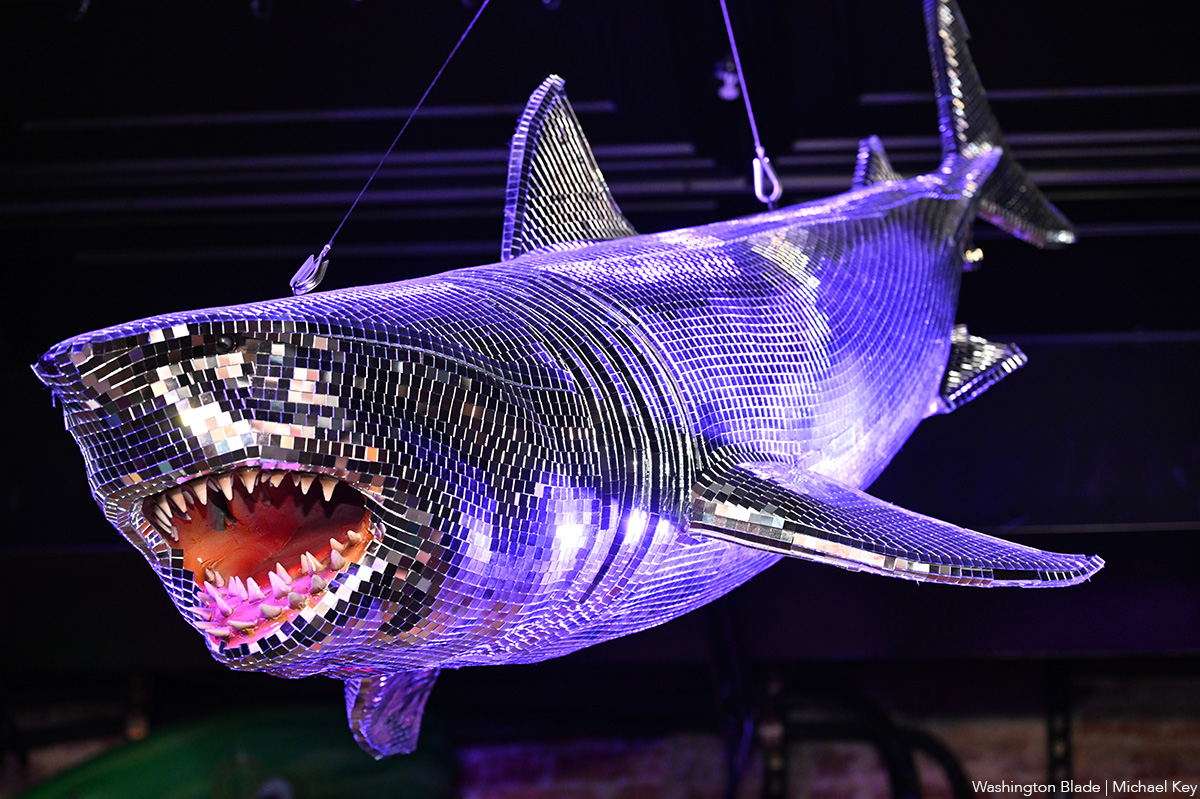
With Christmas in the rear view mirror, we can turn our attention to ringing in a much-anticipated New Year with a slew of local LGBTQ parties. Here’s what’s on tap.
Pitchers
This spacious Adams Morgan bar is hosting the “Pitchers’ Perfect New Year’s Eve.” There will be a midnight Champagne toast, the ball drop on the big screens, and no cover, all night long. The bar doesn’t close until 4 a.m., and the kitchen will be open late (though not until close). All five floors will be open for the party, and party favors are promised.
Trade
D.C.’s hottest bar/club combo is leaning into the Shark motif with its NYE party, “Feeding Frenzy.” The party is a “glitterati-infused Naughty-cal New Year’s Even in the Shark Tank, where the boats are churning and the sharks are circling.” Trade also boasts no cover charge, with doors opening at 5 p.m. and the aforementioned Shark Tank opening at 9 p.m.. Four DJs will be spread across the two spaces; midnight hostess is played by Vagenesis and the two sea sirens sensuously calling are Anathema and Justin Williams.
Number Nine
While Trade will have two DJs as part of one party, Number Nine will host two separate parties, one on each floor. The first floor is classic Number Nine, a more casual-style event with the countdown on TVs and a Champagne midnight toast. There will be no cover and doors open at 5 p.m. Upstairs will be hosted by Capital Sapphics for its second annual NYE gathering. Tickets (about $50) include a midnight Champagne toast, curated drink menu, sapphic DJ set by Rijak, and tarot readings by Yooji.
Crush
Crush will kick off NYE with a free drag bingo at 8 p.m. for the early birds. Post-bingo, there will be a cover for the rest of the evening, featuring two DJs. The cover ($20 limited pre-sale that includes line skip until 11 p.m.; $25 at the door after 9 p.m.) includes one free N/A or Crush, a Champagne toast, and party favors (“the legal kind”). More details on Eventbrite.
Bunker
This subterranean lair is hosting a NYE party entitled “Frosted & Fur: Aspen After Dark New Year’s Eve Celebration.” Arriety from Rupaul Season 15 is set to host, with International DJ Alex Lo. Doors open at 9 p.m. and close at 3 p.m.; there is a midnight Champagne toast. Cover is $25, plus an optional $99 all-you-can-drink package.
District Eagle
This leather-focused bar is hosting “Bulge” for its NYE party. Each District Eagle floor will have its own music and vibe. Doors run from 7 p.m.-3 a.m. and cover is $15. There will be a Champagne toast at midnight, as well as drink specials during the event.
Kiki, Shakiki
Kiki and its new sister bar program Shakiki (in the old Shakers space) will have the same type of party on New Year’s Eve. Both bars open their doors at 5 p.m. and stay open until closing time. Both will offer a Champagne toast at midnight. At Kiki, DJ Vodkatrina will play; at Shakiki, it’ll be DJ Alex Love. Kiki keeps the party going on New Year’s Day, opening at 2 p.m., to celebrate Kiki’s fourth anniversary. There will be a drag show at 6 p.m. and an early 2000s dance party 4-8 p.m.
Spark
This bar and its new menu of alcoholic and twin N/A drinks will host a NYE party with music by DJ Emerald Fox. Given this menu, there will be a complimentary toast at midnight, guests can choose either sparkling wine with or without alcohol. No cover, but Spark is also offering optional wristbands at the door for $35 open bar 11 p.m.-1 a.m. (mid-shelf liquor & all NA drinks).
-

 National5 days ago
National5 days agoWhat to watch for in 2026: midterms, Supreme Court, and more
-

 Opinions5 days ago
Opinions5 days agoA reminder that Jan. 6 was ‘textbook terrorism’
-

 Colombia5 days ago
Colombia5 days agoClaudia López criticizes Trump over threats against Colombian president
-

 District of Columbia4 days ago
District of Columbia4 days agoImperial Court of Washington drag group has ‘dissolved’

